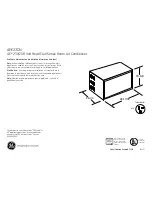
507607-03
Issue 1827
Page 4 of 23
3. Install room thermostat on an inside wall that is not subject to drafts, direct sunshine, or other heat sources.
4. Install low voltage wiring from outdoor to indoor unit and from thermostat to indoor unit (Figure 15).
5. Do not bundle any excess 24V control wire inside control box. Run control wire through installed wire tie and tighten wire
tie to provide low voltage strain relief and to maintain separation of field-installed low and high voltage circuits.
Field Wiring & Routing - Communicating Controls
Maximum length of wiring (18 gauge) for all connections on the RSBus is 1500 feet (457 meters). Wires should be color
coded, with a temperature rating of 95ºF (35ºC) minimum, and solid core (Class II Rated Wiring). All low voltage wiring must
enter unit through provided bushing installed in electrical inlet.
Indoor Unit Controller
Outdoor Unit
Comfort Sync
®
thermostat
Single wire
to terminal C
Single wire
to terminal C
Unused wires
Unused wires
Comfort Sync
®
Thermostat with a
Non-Communicating Outdoor Unit
ENABLED
FURNACE
Comfort Sync
®
THERMOSTAT
NON-COMMUNICATING
OUTDOOR AIR
CONDITIONING UNIT -
1 OR 2 STAGE
Comfort Sync
®
Thermostat
Comfort Sync
®
-Enabled Indoor Furnace
Non-Communicating Outdoor Air Conditioner
OPTIONAL
OUTDOOR
AIR SENSOR
OPTIONAL
DISCHARGE
AIR SENSOR
Comfort Sync
®
Thermostat with an Comfort Sync
®
ENABLED Outdoor Unit
Comfort Sync
®
-Enabled Outdoor Air Conditioner or Heat Pump
OUTDOOR AIR CONDITIONING
OR HEAT PUMP UNIT
OPTIONAL
OUTDOOR
AIR SENSOR
OPTIONAL
DISCHARGE
AIR SENSOR
CLIP ON-BOARD LINK
W915 (Y1 TO Y2) FOR
TWO-STAGE OPERATION
2 STG. ONLY
LSOM ONLY
Comfort Sync
®
Thermostat
Comfort Sync
®
-Enabled Indoor Furnace
Comfort Sync
®
ENABLED
FURNACE
Comfort Sync
®
Comfort Sync
®
THERMOSTAT
Comfort Sync
®
ENABLED
NOTE:
On communicating systems, extra wires must terminate on the “C” Comfort Sync
®
terminal strip (RSBus).
Use an additional wire and come off “C” terminal and wire nut all the extra wires together. Termination on the
outdoor control must match the indoor control.
Figure 5.





































